Financial consolidation has always been one of the most complex and time-consuming tasks for finance teams. As businesses expand across multiple entities, countries, and currencies, bringing all that financial data together into one reliable report becomes a major challenge. SAP Group Reporting is designed to make that entire process seamless, accurate, and faster.
It’s not just another finance tool; it’s an intelligent solution embedded directly within SAP S/4HANA, giving businesses real-time visibility into their group-level financials. In this blog, we’ll explore the best SAP Group Reporting features you should know, along with how they make financial consolidation smarter, simpler, and more transparent.
Why SAP Group Reporting Matters
Before diving into features, let’s understand why SAP Group Reporting has become a preferred choice for modern finance teams.
Traditional consolidation tools often depend on manual uploads, offline spreadsheets, or outdated integration models. These methods lead to inconsistencies, delays, and errors, especially when dealing with multiple subsidiaries.
SAP Group Reporting addresses these pain points by combining accounting, consolidation, and reporting on a single platform. It ensures data accuracy, compliance, and real-time collaboration across the finance function. The result? Faster closes, fewer reconciliations, and more time for analysis instead of fixing data.
Main Advantages of Using SAP Group Reporting
1. Real-Time Data Integration
Let’s start with the biggest advantage: real-time integration.
Unlike legacy consolidation systems that rely on batch data uploads, SAP Group Reporting works natively within SAP S/4HANA. Financial data from operational entities flows automatically into the consolidation system.
This means finance teams always have access to the most current data, making month-end and year-end reporting smoother. There’s no waiting for manual imports or dealing with outdated numbers. This real-time visibility improves accuracy and allows decision-makers to respond faster to financial developments.
2. Unified Platform for Accounting and Consolidation
In most organizations, accounting and consolidation used to happen in separate systems. That often created duplication and long reconciliation processes. SAP Group Reporting eliminates that problem.
It provides a single source of truth for both entity-level and group-level data. The integration between operational accounting and consolidation ensures consistency, accuracy, and speed.
This unified setup not only reduces the number of tools your team manages but also ensures that everyone from accountants to CFOs works with the same financial reality.
3. Flexible Consolidation Rules
Every business operates differently. Some own subsidiaries fully, while others have joint ventures or minority interests. SAP Group Reporting allows you to configure consolidation methods according to your ownership structure and reporting needs.
You can easily set up rules for:
- Full consolidation
- Proportional consolidation
- Equity method accounting
It also supports multiple consolidation hierarchies, allowing you to report financials differently for management and statutory purposes. Flexibility like this makes the system adaptable for complex business structures.
4. Automated Intercompany Eliminations
Intercompany transactions are one of the biggest headaches during consolidation. Inaccurate elimination of intercompany revenues, expenses, or balances can distort financial statements.
SAP Group Reporting automates this process by identifying and matching intercompany transactions across entities. Once matched, the system automatically eliminates them, ensuring that only true external business results are reflected in the final report.
This automation not only saves countless hours but also minimizes human error, something every finance professional appreciates during closing periods.
5. Built-In Validation and Audit Trail
Accuracy and compliance are non-negotiable in financial reporting. SAP Group Reporting strengthens both by offering built-in validation rules and a complete audit trail.
You can define your own validation checks, ensuring data accuracy before consolidation runs. The system also logs every change made to financial data, who made it, when, and why, giving auditors full visibility and accountability.
This feature makes the audit process more efficient and helps finance leaders maintain complete control over financial integrity.
6. Multi-Currency and Multi-GAAP Support
Global organizations deal with multiple currencies and accounting standards. SAP Group Reporting simplifies this complexity by supporting multi-currency and multi-GAAP reporting.
The system automatically converts local entity data into the group currency using standard exchange rates. It also allows parallel reporting under IFRS, US GAAP, or local GAAP, depending on your regulatory requirements.
So, if your company operates across multiple countries, SAP Group Reporting ensures consistency and compliance without extra effort.
7. Seamless Integration with SAP Ecosystem
Since SAP Group Reporting is built on the SAP S/4HANA platform, it integrates effortlessly with other SAP tools such as SAP Analytics Cloud (SAC), SAP Central Finance, and SAP Business Planning and Consolidation (BPC).
This tight integration allows you to connect operational data, analytics, and planning in one ecosystem. For example, using SAC, you can visualize group results, create dashboards, and run scenario-based forecasts all using data directly from Group Reporting.
The result is a more connected and data-driven finance environment.
8. Enhanced Reporting and Analytics
SAP Group Reporting is not just about consolidating numbers; it’s also about delivering insights. Its native integration with SAP Analytics Cloud (SAC) transforms raw financial data into visually rich reports and dashboards.
You can analyze performance trends, compare subsidiaries, and even run predictive models using live financial data. The reporting flexibility allows users to slice and dice data based on segments, regions, or business lines.
This capability turns financial consolidation from a compliance exercise into a strategic decision-making tool.
9. Streamlined Financial Close
Financial close is one of the most stressful times for finance teams. Multiple entities, tight deadlines, and audit requirements can make it overwhelming.
SAP Group Reporting simplifies and speeds up the financial close process through automation and real-time visibility.
You can monitor closing status for each entity, track progress, and identify bottlenecks easily. Since data flows automatically from accounting, you spend less time chasing reports and more time reviewing results.
In short, faster closings mean your finance team can focus more on analysis and less on administration.
10. Cloud-Ready and Future-Proof
SAP Group Reporting is available both on-premise and in the cloud. The cloud version, especially when paired with SAP S/4HANA Cloud, offers scalability, security, and continuous innovation.
With regular updates and enhancements from SAP, you don’t have to worry about maintaining outdated systems. The tool evolves with new regulations, standards, and technologies, ensuring your financial consolidation process remains future-ready.
Final Thoughts
SAP Group Reporting is more than a consolidation solution — it’s a powerful financial management tool designed for connected, data-driven enterprises. With key SAP Group Reporting features like real-time data integration, automated intercompany eliminations, flexible reporting structures, audit-ready consolidation, and embedded analytics, it empowers finance teams to close books faster, ensure compliance, and deliver actionable insights for smarter business decisions.
Whether your organization has a few subsidiaries or operates globally, SAP Group Reporting brings clarity and control to your consolidation process. It simplifies complexity, reduces risk, and empowers finance leaders to focus on what really matters, driving growth with accurate, actionable insights.
In short, if you’re looking for smarter, faster, and more reliable group reporting, SAP Group Reporting is the upgrade your finance team has been waiting for.






